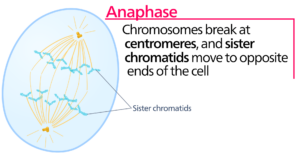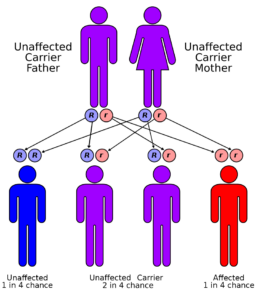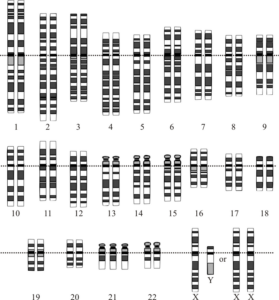Most living cells both plant and animal include chromosomes, which are filamentous structures made of nucleic acids and proteins and that carry genetic information in the form of genes.
A single chromosome is made up of a single DNA molecule wrapped around histone proteins. Information is passed on from one generation to the next via the DNA molecules in the form of genes.
Chromosome functions in animal cell include:
- Carrier of basic genetic materials
- Carrier of Mendelian factors
- Protection of the genetic information
- Regulation of gene action
- Equal distribution of genetic material among sister cells
- Determination of sex
- To keep DNA packed inside the cell nucleus
DNA molecules carry specific instructions about every organism. The compact structure of DNA is maintained because the long DNA molecule is wrapped around circular protein molecules called histones, like threads wrapping around a spool. If this arrangement was not maintained, then it would be impossible to fit all the DNA inside the cell nucleus. For example, if not compacted a single DNA molecule in a single human cell is laid out unraveled it would be a massive 6 feet tall.
Detailed discussion of chromosome functions in animal cell:
Chromosomes carry genetic information:
The most basic and vital function that chromosomes perform is to carry the genetic information stored in the DNA from one cellular generation to the next and then from parent to offspring. DNA contains genetic information that is used to perform a variety of biological tasks. These functions are necessary for the organism’s growth, survival, and reproduction.
Chromosomes allow large DNA molecules to be packed inside the cell:
The chromosomal structure makes sure that the DNA molecule is compactly wound around the circular molecules called histones. Without this feature, it would be impossible to compact the huge DNA molecule inside the cell nucleus. Chromosomes can further condense to chromatids during cell division for easier chromosomal distribution.
Chromosome regulates gene action:
Chromosomes not only contain histone proteins but also others that are simply referred to as non-histone proteins. These proteins control gene activity. Cellular molecules that regulate genes can activate or deactivate these proteins at will. The chromosomes can expand and contract in various situations based on the activation and deactivation of these gene regulatory molecules.
Chromosomes carry Mendelian factors:
Considering the chromosomal theory of inheritance, which says that chromosomes carry Mendelian factors. This includes height, hair colour, eye colour, diseases, blood groups and many more. Hence the offspri1ng are equally influenced by the factors coming from both parents
They protect the genetic information:
Chromosomes are protected from chemical (e.g., enzymes) and physical forces by histones and some other proteins. As a result, chromosomes, in turn, safeguard the genetic material i.e. the DNA from damage during cell division when the nuclear membrane dissolves.
Sex chromosomes determine the gender of animals:
An allosome or simply a sex chromosome is the type of chromosome that determines a person’s gender. Humans and most other mammals have the X and Y chromosomes. In their cells, males have both X and Y chromosomes, whereas females have two X chromosomes. Hence all egg cells have X chromosomes, whereas sperm cells have either X or Y chromosomes. This system proves that the sex of the offspring after fertilization is dictated by the chromosome of the father rather than the mother.

Image: Wikipedia
Chromosomes allow for the equal distribution of genetic material during cell division:
Spindle fibres connect to the centromeres of chromosomes and contract during the anaphase stage of cell division thereby pulling the sister chromatids apart. The contraction spindle fibres ensure that DNA (genetic material) is distributed evenly to daughter nuclei as sister chromatids are separated. The spindle fibres attach to the centromere when they are pulled apart to the sister cells.

Image: Wikipedia
How does chromosomal inheritance work?
Technically a child gets one chromosome from either parent to form a pair. Meaning in every pair of chromosomes in a single cell is a sister chromosome derived from the mother and the other from the father. Now it is absolutely luck which of the alleles are more prominently seen in the offspring.
The mitochondrial circular chromosome has a distinct inheritance pattern. Only egg cells, not sperm cells, keep their mitochondria during fertilisation. As a result, a child inherits its mitochondrial DNA from the mother without exception.
Several human diseases, including various types of hearing loss and diabetes, are thought to be transmitted from the mother via the mitochondrial DNA. Alleles are genetic pairings that influence a variety of our features.
Genetic disorders:
Some common genetic disorders include:
Thalassemia:
Thalassemia is a group of hereditary genetic disorders that decrease the quantity of haemoglobin a person can make naturally. This disorder prevents oxygen from reaching all parts of the body. Thalassemia is a recessive gene disease. This means if both parents have a thalassemia gene, there is a 25% chance that the child is born with Thalassemia carrying the recessive gene from both parents. There is also a 50%chance of the child being an asymptomatic carrier, which does not affect them greatly but v=can affect their future generation in turn. With any type of Thalassemia, severe anaemia is frequent, demanding specialised care such as regular blood transfusions and chelation therapy.
Sickle cell anemia:
Sickle Cell Disease is another recessive gene hereditary illness that can be passed on to offspring if both parents have the Sickle Cell recessive gene. People having sub-Saharan, Indian, or Mediterranean ancestry are more likely to inherit the characteristic. Red blood cells in Sickle Cell Disease take on a sickle shape instead of the usual concave shape.

Image: Wikipedia
The reason for the shape change is that A single amino acid is mutated in the Hb gene causing the codon to change from GAG to GUC changing the amino acid from Glutamic acid to Valine. This results in the cell changing from its normal concave shape, to a sickle shape, which decreases its surface area and stability. These cells hence end up rupturing and aggregating into lumps clogging blood vessels. Often it can lead to internal bleeding, infections, organ failure or even acute respiratory syndrome.
Down Syndrome:
Down syndrome is a disease caused by the abnormality in the chromosome number causing a child to be born with 47 total chromosomes instead of the normally occurring 46. Genes in chromosomes shape and function the body of a baby as it develops throughout pregnancy and after birth. In most cases, a baby is born with 46 chromosomes or 23 pairs.

Image: Wikipedia
Down syndrome is caused when one of these chromosomes, chromosome 21, creates an extra copy, resulting in three chromosomes instead of two, resulting in a total count of 47. A chromosome with an extra copy is referred to as a trisomy. Down syndrome is also medically termed trisomy 21. Down’s seriously causes a baby’s body and brain to develop differently as a result of the additional copy, resulting in physical and metal disruptions to their normal growth.
Also Read:
- Anticodon function
- Function of cytosine
- Cytoplasm function in animal cell
- Adenine function in rna
- Cytoplasm function
- Function of cytoplasm in bacteria
- Parenchyma cells function
- Function of plasmid in bacteria
- Golgi apparatus function
- Function of vacuole in animal cell

I am Trisha Dey, a postgraduate in Bioinformatics. I pursued my graduate degree in Biochemistry. I love reading .I also have a passion for learning new languages.
Let’s connect through linked in: